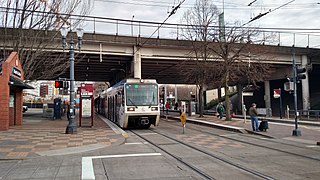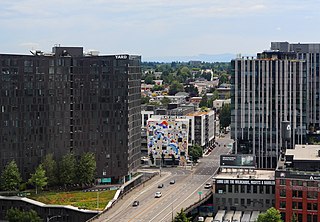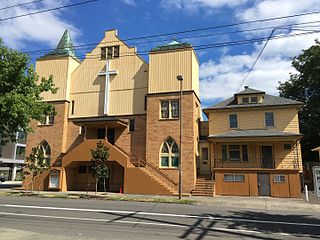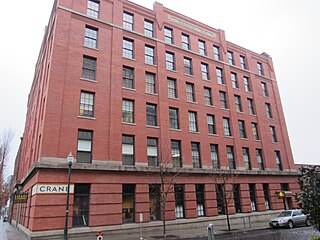
The Patton Home is a historic building and low-income housing facility in Portland, Oregon, United States. It was once known as the Patton Home for the Friendless. [1] It was listed on the National Register of Historic Places in 2021. [2]

The Patton Home is a historic building and low-income housing facility in Portland, Oregon, United States. It was once known as the Patton Home for the Friendless. [1] It was listed on the National Register of Historic Places in 2021. [2]
The building, originally used as a retirement home, was built in 1890 on Michigan Avenue in the Albina district of Portland. Matthew Patton, who arrived in Oregon in 1847, donated the land for use as a home for the aged. [3] Since its opening, the Patton Home has served the Albina neighborhood of north Portland for over 100 years. The Patton Home offers shelter and care for those in need.
During the late 1990s, the Patton Home was purchased by the Ecumenical Ministries of Oregon (EMO) who then invested $6 million in renovating the building in order to briefly operate the Patton Home as a residential care facility before EMO transitioned the facility to serve as a specialized drug- and alcohol-free living environment for low-income individuals.
The grounds of the Patton Home occupy the whole block of Michigan Avenue and are located on the east side of Interstate 5. The Patton Home currently provides housing to 63 low-income residents. The grounds also contain a veranda for socializing and a community garden.

The Hawthorne District in Portland, Oregon, is an area of Southeast Portland on SE Hawthorne Blvd. that runs from 12th to 60th Avenues, with the primary core of businesses between 30th and 50th Avenues. The area has numerous retail stores, including clothing shops, restaurants, bars, brewpubs and microbreweries.

Klickitat Street is a city street located in northeast Portland, Oregon, United States. The main stem of the street is 3.75-mile (6.04 km) long, and runs east-west parallel to—and one block south of—northeast Fremont Street, from the eastern edge of Irving Park to Northeast 67th Avenue. Additional disconnected segments are east of Rocky Butte from 105th to 117th, 148th to 154th, and 163rd to 165th. A segment named Klickitat Court is between 135th and 140th.

Rose Quarter Transit Center is a light rail station in the MAX system and a TriMet bus transit center, and is located in the Rose Quarter area of Portland, Oregon, a part of the Lloyd District. It is served by the Blue, Green and Red Lines. It is currently the 7th stop eastbound on the Eastside MAX as well as the first stop after crossing the Willamette River on the Steel Bridge. Two hundred yards west of the station is the Interstate/Rose Quarter station on the MAX Yellow Line.

St. Johns is a neighborhood of Portland, Oregon, United States, located in North Portland on the tip of the peninsula formed by the confluence of the Willamette River and the Columbia River. It was a separate, incorporated city from 1902 until 1915, when citizens of both St. Johns and Portland voted to approve its annexation to Portland, which took effect on July 8, 1915.

Kenton is a neighborhood in the north section of Portland, Oregon, United States. The neighborhood was originally a company town founded in 1911 for the Swift Meat Packing Company.

Alberta Arts District is a commercial district in Portland, Oregon which connects the Concordia, King and Vernon neighborhoods in the Northeast quadrant of the city. The district centers on NE Alberta Street, and stretches approximately 1.5 miles (2.4 km), from Martin Luther King Jr. Boulevard to NE 33rd Avenue.

Southwest Hills is a neighborhood in the West Hills in the southwest section of Portland, Oregon, United States. The northeastern part of the neighborhood, above Goose Hollow and Downtown Portland, is known as Portland Heights. Much of the western portion of the neighborhood lies outside the Portland city limits, in unincorporated Multnomah County.

Albina is a historical American city that was consolidated into Portland, Oregon in 1891.

East Portland was a city in the U.S. state of Oregon that was consolidated into Portland in 1891. In modern usage, the term generally refers to the portion of present-day Portland that lies east of 82nd Avenue, most of which the City of Portland annexed in the 1980s and 1990s.

Legacy Emanuel Medical Center is a hospital located in the Eliot neighborhood of Portland, Oregon, United States. Founded in 1912, it is one of only two Level I trauma centers in the state of Oregon, and home to the only burn center between Seattle and Sacramento. The hospital is also home to the Life Flight Network (MEDEVAC), the first of its kind instituted on the U.S. West Coast. The 554-bed facility provides a full range of services, including conventional surgery, heart treatment, critical care, neurology/stroke care/brain surgery, and care for high-risk pregnancies. Legacy Emanuel also houses the Randall Children's Hospital.

The Hamilton Hotel in Portland, Oregon, originally the Venable, was designed by Portland architect John V. Bennes's Bennes & Hendricks firm and built in 1913. It was four stories and in the Classic Revival Commercial Style.

The Peter Jeppesen House is a house located in north Portland, Oregon listed on the National Register of Historic Places.

North Williams Avenue is a north-south street located in Portland, Oregon, United States, and it defines the eastern boundary of North Portland. North Williams Avenue stretches from its southern terminus at Northeast Winning Way, near the Moda Center, to its northern terminus at North Winchell Street, a distance of 3.3 miles (5.3 km). It is a street common to the Portland neighborhoods Eliot, Boise, Humboldt, and Piedmont.

The Burnside Bridgehead is a development project at the northeast end of the Burnside Bridge in Portland, Oregon's Kerns neighborhood, in the United States.

The Vancouver Avenue First Baptist Church, located at 3138 North Vancouver Avenue in Portland, Oregon's Eliot neighborhood, was listed on the National Register of Historic Places in 2016.

KFFP-LP is a low-power listener supported Independent radio station in Portland, Oregon. It broadcasts live programming at 90.3 FM 24 hours a day, seven days a week. It first began broadcasting live in April 2016.

The Eastmoreland Historic District is a proposed historic district for National Register of Historic Places listing within Portland, Oregon's Eastmoreland neighborhood, in the United States.

Albina is a collection of neighborhoods located in the North and Northeast sections of Portland, Oregon, United States. For most of the 20th century it was home to the majority of the city’s African American population. The area derives its name from Albina, Oregon, a historical American city that was consolidated into Portland in 1891. Albina includes the modern Portland neighborhoods of Eliot, Boise, Humboldt, Irvington, King, Overlook, and Piedmont.

Lombard Street is a main thoroughfare in North and Northeast Portland, Oregon. It serves as a boundary and main commercial street for several North Portland neighborhoods.

The Crane Building is an historic building in Portland, Oregon. Completed in 1909, the structure is part of the Portland Thirteenth Avenue Historic District, which is listed on the National Register of Historic Places.